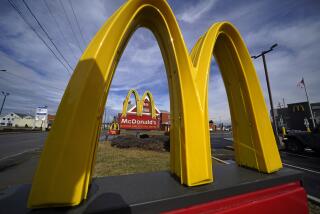In this economy, French fries are toast
- Share via
Reporting from Chicago — Fries have been getting downsized.
The introduction of dollar menus, effects of the recession and the end of super-sizing have taken a toll on French fry consumption at restaurants. Fries are a part of 13.2% of restaurant meals today, down from 14.5% in 2004, according to NPD Group.
But fast-food giants haven’t been taking this lying down. Many have been finding ways to offset the decline in fry sales.
McDonald’s Corp., the longtime king of fries, has cited breakfast business and the introduction of frappes and smoothies for helping the chain score 31 consecutive quarters of same-store-sales gains. Wendy’s recently launched a premium version of fries: hand-cut and sprinkled with sea salt.
Though experts say French fry sales are likely to grow as the economy improves, they say consumption is unlikely to return to previous levels.
Even some of the most avid French fry consumers say they’ve been cutting back.
Jocelyn Geboy, of Andersonville, Ill., is a French fry aficionado. But a few years ago, she said, “I noticed I was content after a burger and a small fry, or a burger and a couple chicken nuggets and a small fry.”
Even her friends who are in their 20s are conscious of the foods they eat. They’ll order fries, she said, but that typically comes with a side of guilt and prompts such comments as “I’ll have to work out extra hard tomorrow.”
Although some experts see signs of more healthful eating, particularly among seniors and children — many are ordering apple slices instead of fries — others point to the recession. Many consumers have been bypassing $5 combo meals, which typically include fries and a drink, and instead are ordering two sandwiches and a $1 drink from the value menu.
Darren Tristano, executive vice president of Technomic, a Chicago restaurant consulting firm, said the fates of French fries and the economy are inextricably linked.
“As America becomes smarter and more frugal — and even post-recession, these behaviors are continuing — we’re focusing less on sides and more on main courses and beverages,” he said. “The dollar drink is a must-have; McDoubles for a dollar is a must. When you’re looking at fries for $1.29 to $2, it’s likely going to be left behind in many purchases.”
Executives at McDonald’s, based in Oak Brook, Ill., have acknowledged that the average check amount has declined in part because customers were ordering fewer combo meals. Instead, they’re choosing their own combination of items and visiting between meals for such items as smoothies.
“This is a category that’s been a little bit sleepy for a while,” said Ken Calwell, chief marketing officer of Dublin, Ohio-based Wendy’s International Inc. “Over the last 10 years there has been a lot of new hamburger products that have come out, chicken sandwiches, dairy products, salads, new 99 cent [items]. There’s been innovation across the category. But there’s been very little, if any, innovation across the French fry area.”
Wendy’s has been gradually overhauling its core menu items since the chain was acquired by Triarc Cos. in 2008. When Wendy’s surveyed customers about how they like their fries, Calwell said, natural, skin-on and sea-salted were attributes at the top of lists.
The decline in fry sales has strained potato farmers, who have cut production and, in some cases, turned to growing other crops.
“The potato industry has been affected by the economy — that’s no secret,” said Don Odiorne, of the Idaho Potato Commission.
French fry sales are expected to improve in 2011 over last year. Farmers planted more potatoes this year after several years of declines, based on increased orders from fast-food chains and other clients, Odiorne said. Now inventories are low enough that there’s even concern about a shortage.
Still, it’s a long way back to the peak of French fry consumption, and most experts don’t think it will happen. Instead, some point to other products such as baked potatoes, potato pancakes and sweet-potato fries.
Mark Hayden, senior vice president of sales at ConAgra Foods’ Lamb Weston unit, said that if the industry is innovative, it eventually should return to pre-recession levels.
“I would argue that if we don’t do that, it’ll stay pretty constant,” he said.
Lamb Weston, which is one of McDonald’s primary potato suppliers, recently opened a sweet-potato processing facility. The company has reported sweet-potato sales increases at or above 50% over the last few years.
A few restaurant chains are launching or testing sweet-potato fries, among them Hardee’s, Carl’s Jr. and Culver’s.
Harry Balzer, chief industry analyst for NPD, said fries are still America’s favorite side dish, even if it’s no longer the most-ordered food. Hamburgers nabbed that distinction in recent years.
“The desire for new is insatiable,” Balzer said. Consumers are essentially saying, ‘Who’s doing something new in the category for fried? Because I’m waiting for it.’”
More to Read
Eat your way across L.A.
Get our weekly Tasting Notes newsletter for reviews, news and more.
You may occasionally receive promotional content from the Los Angeles Times.










